 W
WPenguins are a group of aquatic flightless birds. They live almost exclusively in the Southern Hemisphere, with only one species, the Galápagos penguin, found north of the equator. Highly adapted for life in the water, penguins have countershaded dark and white plumage and flippers for swimming. Most penguins feed on krill, fish, squid and other forms of sea life which they catch while swimming underwater. They spend roughly half of their lives on land and the other half in the sea.
 W
WThe Adélie penguin is a species of penguin common along the entire coast of the Antarctic continent, which is its only habitat. It is the most widely spread penguin species, as well as the most southerly distributed of all penguins, along with the emperor penguin. It is named after Adélie Land, in turn named for Adèle Dumont d'Urville, the wife of French explorer Jules Dumont d'Urville, who first discovered this penguin in 1840. Adélie penguins obtain their food by both predation and foraging, with a diet of mainly krill and fish.
 W
WThe African penguin, also known as the Cape penguin or South African penguin, is a species of penguin confined to southern African waters. Like all extant penguins, it is flightless, with a streamlined body and wings stiffened and flattened into flippers for a marine habitat. Adults weigh an average of 2.2–3.5 kg (4.9–7.7 lb) and are 60–70 cm (24–28 in) tall. The species has distinctive pink patches of skin above the eyes and a black facial mask. The body upperparts are black and sharply delineated from the white underparts, which are spotted and marked with a black band. The pink glands above their eyes help them with thermoregulation. To cope with changing temperatures, blood is sent to the glands to be cooled by the air.
 W
WThe genus Aptenodytes contains two extant species of penguins collectively known as "the great penguins".
 W
WThe banded penguins are penguins that belong to the genus Spheniscus. There are four living species of penguins known as banded penguins, and all have similar coloration. They are sometimes also known as "jack-ass penguins" due to their loud locator calls sounding similar to a donkey braying. Common traits include a band of black that runs around their bodies bordering their black dorsal coloring, black beaks with a small vertical white band, distinct spots on their bellies, and a small patch of unfeathered or thinly feathered skin around their eyes and underdeveloped fluff sack that can be either white or pink. All members of this genus lay eggs and raise their young in nests situated in burrows or natural depressions in the earth.
 W
WThe chinstrap penguin is a species of penguin that inhabits a variety of islands and shores in the Southern Pacific and the Antarctic Oceans. Its name stems from the narrow black band under its head, which makes it appear as if it were wearing a black helmet, making it easy to identify. Other common names include ringed penguin, bearded penguin, and stonecracker penguin, due to its loud, harsh call.
 W
WThe term crested penguin is the common name given collectively to species of penguins of the genus Eudyptes. The exact number of species in the genus varies between four and seven depending on the authority, and a Chatham Islands species became extinct in recent centuries. All are black and white penguins with yellow crests, red bills and eyes, and are found on Subantarctic islands in the world's southern oceans. All lay two eggs, but raise only one young per breeding season; the first egg laid is substantially smaller than the second.
 W
WThe eastern rockhopper penguin is a crested penguin with yellow crest feathers. It is a subspecies of the southern rockhopper penguin found in subantarctic regions and the Indian Ocean. It is one of the smallest crested penguins and has distinctive pink margins around its bill.
 W
WThe emperor penguin is the tallest and heaviest of all living penguin species and is endemic to Antarctica. The male and female are similar in plumage and size, reaching 100 cm (39 in) in length and weighing from 22 to 45 kg. Feathers of the head and back are black and sharply delineated from the white belly, pale-yellow breast and bright-yellow ear patches.
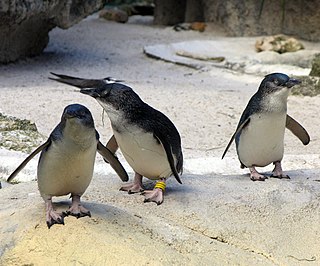 W
WThe genus Eudyptula contains two species of penguin, found in southern Australia, Tasmania, and New Zealand. They are commonly known as the little penguin, little blue penguin, or, in Australia, fairy penguin. In the language of the Māori people of New Zealand, little penguins are known as kororā.
 W
WThe Fiordland penguin, also known as the Fiordland crested penguin, is a crested penguin species endemic to New Zealand. It currently breeds along the south-western coasts of New Zealand's South Island as well as on Stewart Island/Rakiura and its outlying islands. Because it originally ranged beyond Fiordland, it is sometimes referred to as the New Zealand crested penguin.
 W
WThe gentoo penguin is a penguin species in the genus Pygoscelis, most closely related to the Adélie penguin and the chinstrap penguin. The earliest scientific description was made in 1781 by Johann Reinhold Forster with a type locality in the Falkland Islands. They call in a variety of ways, but the most frequently heard is a loud trumpeting which the bird emits with its head thrown back.
 W
WThe Humboldt penguin is a South American penguin living mainly in the Pingüino de Humboldt National Reserve in the North of Chile, although its habitat comprises most of coastal Chile and Peru. Its nearest relatives are the African penguin, the Magellanic penguin and the Galápagos penguin. The Humboldt penguin and the cold water current it swims in both are named after the explorer Alexander von Humboldt. The species is listed as vulnerable by the IUCN with no population recovery plan in place. The current population is composed of 32,000 mature individuals and is going down. It is a migrant species.
 W
WThe king penguin is the second largest species of penguin, smaller, but somewhat similar in appearance to the emperor penguin. There are two subspecies: A. p. patagonicus and A. p. halli; patagonicus is found in the South Atlantic and halli in the South Indian Ocean and at Macquarie Island.
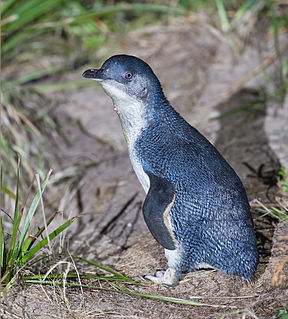 W
WThe little penguin is the smallest species of penguin. It grows to an average of 33 cm (13 in) in height and 43 cm (17 in) in length, though specific measurements vary by subspecies. It is found on the coastlines of southern Australia and New Zealand, with possible records from Chile. In Australia, they are often called fairy penguins because of their small size. In New Zealand, they are more commonly known as little blue penguins or blue penguins owing to their slate-blue plumage; they are also known by their Māori name: kororā.
 W
WThe macaroni penguin is a species of penguin found from the Subantarctic to the Antarctic Peninsula. One of six species of crested penguin, it is very closely related to the royal penguin, and some authorities consider the two to be a single species. It bears a distinctive yellow crest, and the face and upperparts are black and sharply delineated from the white underparts. Adults weigh on average 5.5 kg (12 lb) and are 70 cm (28 in) in length. The male and female are similar in appearance; the male is slightly larger and stronger with a relatively larger bill. Like all penguins, it is flightless, with a streamlined body and wings stiffened and flattened into flippers for a marine lifestyle.
 W
WThe Magellanic penguin is a South American penguin, breeding in coastal Patagonia, including Argentina, Chile and the Falkland Islands, with some migrating to Brazil where they are occasionally seen as far north as Espirito Santo. It is the most numerous of the Spheniscus penguins. Its nearest relatives are the African penguin, the Humboldt penguin, and the Galápagos penguins. The Magellanic penguin was named after Portuguese explorer Ferdinand Magellan, who spotted the birds in 1520. The species is listed as Near Threatened by the IUCN.
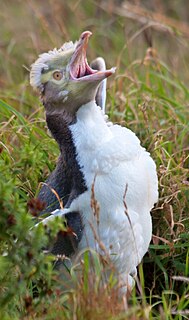 W
WMegadyptes is a genus of penguin which consists of two species, yellow-eyed penguin and the extinct Waitaha penguin.
 W
WRecent studies show the northern rockhopper penguin, Moseley's rockhopper penguin, or Moseley's penguin distinct from the southern rockhopper penguin.
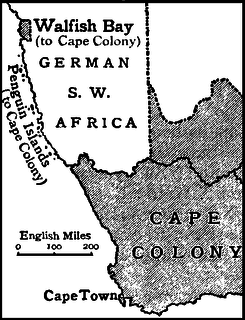 W
WThe Penguin Islands are a historical group of mostly scattered islands and rocks situated along a stretch of 355 kilometres (221 mi) along the coastline of Namibia. Not forming a geographic whole, the Namibian government formally lists them as the Off-Shore islands. Their name comes from the presence of African penguins which inhabit the coastal region surrounding Namibia and South Africa.
 W
WA penguinarium is a vivarium for penguins intended to simulate aspects of their natural environment.
 W
WThe genus Pygoscelis ("rump-legged") contains three living species of penguins collectively known as "brush-tailed penguins".
 W
WThe rockhopper penguins are three closely related taxa of crested penguins that have been traditionally treated as a single species and are sometimes split into three species.
 W
WThe royal penguin is a subspecies of penguin, which can be found on the sub-Antarctic Macquarie Island and adjacent islands. It is a localised variant of the Macaroni penguin. The International Union for Conservation of Nature (IUCN) classifies the royal penguin as near threatened. The scientific name commemorates the German zoologist Hermann Schlegel.
 W
WThe Snares penguin, also known as the Snares crested penguin and the Snares Islands penguin, is a penguin from New Zealand. The species breeds on The Snares, a group of islands off the southern coast of the South Island. This is a medium-small, yellow-crested penguin, at a size of 50–70 cm (19.5–27.5 in) and a weight of 2.5–4 kg (5.5–8.8 lb). It has dark blue-black upperparts and white underparts. It has a bright yellow eyebrow-stripe which extends over the eye to form a drooping, bushy crest. It has bare pink skin at the base of its large red-brown bill.
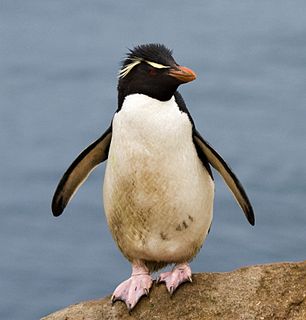 W
WThe southern rockhopper penguin group, are two subspecies of rockhopper penguin, that together are sometimes considered distinct from the northern rockhopper penguin. It occurs in subantarctic waters of the western Pacific and Indian Oceans, as well as around the southern coasts of South America.
 W
WThe banded penguins are penguins that belong to the genus Spheniscus. There are four living species of penguins known as banded penguins, and all have similar coloration. They are sometimes also known as "jack-ass penguins" due to their loud locator calls sounding similar to a donkey braying. Common traits include a band of black that runs around their bodies bordering their black dorsal coloring, black beaks with a small vertical white band, distinct spots on their bellies, and a small patch of unfeathered or thinly feathered skin around their eyes and underdeveloped fluff sack that can be either white or pink. All members of this genus lay eggs and raise their young in nests situated in burrows or natural depressions in the earth.
 W
WThe white-flippered penguin is a small penguin about 30 cm (12 in) tall and weighing 1.5 kg (3.3 lb). It gains its name from the white markings on its flippers, unique to the subspecies. It nests only on Banks Peninsula and Motunau Island, near Christchurch, New Zealand, with only around 3,750 breeding pairs.
 W
WThe yellow-eyed penguin, known also as hoiho or tarakaka, is a species of penguin endemic to New Zealand.